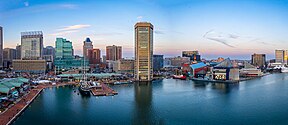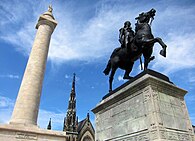
Back Baltimore Afrikaans ባልቲሞር Amharic Bealdimōr ANG بالتيمور Arabic بالتيمور ARZ Baltimore AST Baltimor Azerbaijani بالتیمور AZB Baltimore BAR Балтымар Byelorussian
Baltimore | |
|---|---|
| Nicknames: | |
| Motto(s): | |
 Interactive map of Baltimore | |
Location of Baltimore in Maryland Location in the United States | |
| Coordinates: 39°17′22″N 76°36′55″W / 39.28944°N 76.61528°W | |
| Country | United States |
| State | Maryland |
| City | Baltimore |
| Historic colony | Province of Maryland |
| County | None (Independent city) |
| Founded | August 8, 1729 |
| Incorporated | 1796–1797 |
| Independent city | 1851 |
| Named for | Cecil Calvert, 2nd Baron Baltimore |
| Government | |
| • Type | Mayor–council |
| • Body | Baltimore City Council |
| • Mayor | Brandon Scott (D) |
| • City Council | Council members
|
| • Houses of Delegates | Delegates
|
| • State Senate | State senators
|
| Area | |
| 92.05 sq mi (238.41 km2) | |
| • Land | 80.95 sq mi (209.65 km2) |
| • Water | 11.10 sq mi (28.76 km2) 12.1% |
| Elevation | 0–480 ft (0–150 m) |
| Population (2020) | |
| 585,708 | |
• Estimate (2021)[7] | 576,498 |
| • Rank | 83rd in North America 30th in the United States 1st in Maryland |
| • Density | 7,235.43/sq mi (2,793.74/km2) |
| • Urban | 2,212,038 (US: 20th) |
| • Urban density | 3,377.5/sq mi (1,304.1/km2) |
| • Metro | 2,844,510 (US: 20th) |
| Demonym | Baltimorean[10] |
| GDP | |
| • Independent city | $59.380 billion (2022) |
| • Metro | $241.399 billion (2022) |
| Time zone | UTC−5 (EST) |
| • Summer (DST) | UTC−4 (EDT) |
| ZIP Codes | ZIP Codes[13] |
| Area codes | 410, 443, and 667 |
| Congressional districts | 2nd, 7th |
| GNIS feature ID | 597040 |
| Website | www |
Baltimore[a] is the most populous city in the U.S. state of Maryland. With a population of 585,708 at the 2020 census, it is the 30th-most populous US city.[15] Baltimore was designated as an independent city by the Constitution of Maryland[b] in 1851, and is the most populous independent city in the nation. As of 2020[update], the population of the Baltimore metropolitan area was 2,838,327, the 20th-largest metropolitan area in the country.[16] The city is also part of the Washington–Baltimore combined statistical area (CSA), which had a 2020 population of 9,973,383, the third-largest in the country.[16] Though Baltimore is not located within or under the administrative jurisdiction of any county in the state, it is part of the Central Maryland region, together with the surrounding county that shares its name.
The land that is present-day Baltimore was used as hunting ground by Paleo-Indians. In the early 1600s, the Susquehannock began to hunt there.[17] People from the Province of Maryland established the Port of Baltimore in 1706 to support the tobacco trade with Europe, and established the Town of Baltimore in 1729. During the American Revolutionary War, the Second Continental Congress, fleeing Philadelphia prior to its fall to British troops, moved their deliberations to Henry Fite House on West Baltimore Street from December 1776, to February 1777, permitting Baltimore to serve briefly as the nation's capital, before it returned to Philadelphia in March 1777. The Battle of Baltimore was pivotal during the War of 1812, culminating in the failed British bombardment of Fort McHenry, during which Francis Scott Key wrote a poem that would become "The Star-Spangled Banner", designated as the national anthem in 1931.[18] During the Pratt Street Riot of 1861, the city was the site of some of the earliest violence associated with the American Civil War.
The Baltimore and Ohio Railroad, the nation's oldest, was built in 1830 and cemented Baltimore's status as a transportation hub, giving producers in the Midwest and Appalachia access to the city's port. Baltimore's Inner Harbor was the second leading port of entry for immigrants to the US and a major manufacturing center.[19] After a decline in major manufacturing, heavy industry, and restructuring of the rail industry, Baltimore has shifted to a service-oriented economy. Johns Hopkins Hospital and University are the top employers.[20] The city is plagued by high rates of violent crime and has the second highest per capita homicide rate in the United States. Baltimore is home to the Baltimore Orioles of Major League Baseball, and the Baltimore Ravens of the National Football League.
Many Baltimore neighborhoods have rich histories. The city is home to some of the earliest National Register Historic Districts in the nation, including Fell's Point, Federal Hill, and Mount Vernon. Baltimore has more public statues and monuments per capita than any other city in the country.[21] Nearly one third of the buildings (over 65,000) are designated as historic in the National Register, more than any other US city.[22][23] Baltimore has 66 National Register Historic Districts and 33 local historic districts.[22] The historical records of the government of Baltimore are located at the Baltimore City Archives.
- ^ a b c Donovan, Doug (May 20, 2006). "Baltimore's New Bait: The City is About to Unveil a New Slogan, 'Get In On It,' Meant to Intrigue Visitors". The Baltimore Sun. Retrieved November 28, 2008 – via RedOrbit.
- ^ Kane, Gregory (June 15, 2009). "Dispatch from Bodymore, Murderland". The Washington Examiner.
- ^ Cutler, Josh S. (February 18, 2019). Mobtown Massacre: Alexander Hanson and the Baltimore Newspaper War of 1812. Arcadia. ISBN 978-1-4396-6620-3.
- ^ Gettleman, Jeffrey (September 2, 2003). "In Baltimore, Slogan Collides with Reality". The New York Times.
- ^ "2019 U.S. Gazetteer Files". United States Census Bureau. Retrieved July 25, 2020.
- ^ "Highest and Lowest Elevations in Maryland's Counties". Maryland Geological Survey. Maryland Department of Natural Resources. Baltimore City. Archived from the original on October 5, 2007. Retrieved November 14, 2007.
- ^ Cite error: The named reference
popchange21was invoked but never defined (see the help page). - ^ "List of 2020 Census Urban Areas". census.gov. United States Census Bureau. Retrieved January 8, 2023.
- ^ "2020 Population and Housing State Data". United States Census Bureau. Retrieved August 22, 2021.
- ^ Spaniel, Bill (October 31, 2019). "Demonyms find their place in our lexicon and across the country". prdaily.com. Ragan PR Daily/Ragan Insider. Retrieved July 29, 2023.
- ^ "Gross Domestic Product: All Industries in Baltimore City, MD". fred.stlouisfed.org.
- ^ "Total Gross Domestic Product for Baltimore-Columbia-Towson, MD (MSA)". fred.stlouisfed.org.
- ^ "ZIP Code Lookup". USPS. Archived from the original on November 22, 2010. Retrieved October 13, 2014.
- ^ Britto, Brittany. "How Baltimore talks". The Baltimore Sun. Archived from the original on August 7, 2022. Retrieved September 9, 2022.
- ^ "QuickFacts: Baltimore city (County)". United States Census Bureau. Retrieved August 16, 2021.
- ^ a b "Metropolitan and Micropolitan Statistical Areas Population Totals: 2020–2021" (CSV). 2021 Population Estimates. United States Census Bureau, Population Division. May 2022. Retrieved May 29, 2022.
- ^ Youssi, Adam (2006). "The Susquehannocks' Prosperity & Early European Contact". Historical Society of Baltimore County. Retrieved April 28, 2015.
- ^ "About Baltimore". Baltimore.org. Archived from the original on July 25, 2013. Retrieved July 8, 2013.
- ^ "Baltimore Heritage Area". Maryland Historical Trust. February 11, 2011. Archived from the original on February 2, 2012. Retrieved December 30, 2011.
- ^ "Major Employers | Baltimore Development Corporation". Baltimoredevelopment.com. Archived from the original on July 25, 2010. Retrieved July 8, 2013.
- ^ Gibbons, Mike (October 21, 2011). "Monumental City Welcomes Number Five". Babe Ruth Birthplace Foundation. Retrieved February 6, 2016.
- ^ a b Sherman, Natalie (March 14, 2015). "Historic districts proliferate as city considers changes". The Baltimore Sun. Archived from the original on July 11, 2017.
- ^ "Building on Baltimore's History: The Partnership for Building Reuse" (PDF). Preservation Green Lab, National Trust for Historic Preservation and the Urban Land Institute Baltimore. November 2014. Archived from the original (PDF) on October 10, 2017. Retrieved July 11, 2017.
Cite error: There are <ref group=lower-alpha> tags or {{efn}} templates on this page, but the references will not show without a {{reflist|group=lower-alpha}} template or {{notelist}} template (see the help page).









